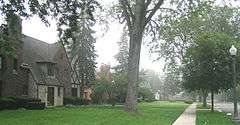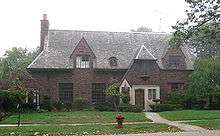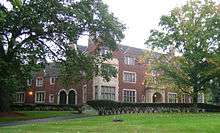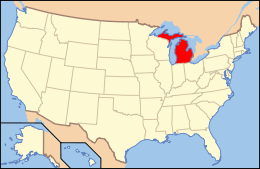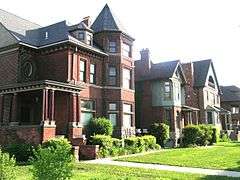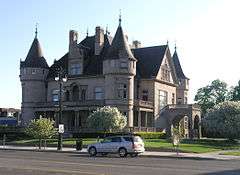Palmer Woods
|
Palmer Woods Historic District | |
|
Streetscape along Strathcona | |
| Location |
Detroit, Michigan |
|---|---|
| Coordinates | 42°26′5″N 83°7′28″W / 42.43472°N 83.12444°WCoordinates: 42°26′5″N 83°7′28″W / 42.43472°N 83.12444°W |
| Built | 1915 |
| Architect | Multiple |
| Architectural style | Colonial Revival, Tudor Revival |
| NRHP Reference # | 83000896[1] |
| Added to NRHP | August 11, 1983 |
The Palmer Woods Historic District is a residential historic district bounded by Seven Mile Road, Woodward Avenue, and Strathcona Drive in Detroit, Michigan. There are approximately 295 homes in the 188-acre (0.76 km2) district,[2] which is between the City of Highland Park in Wayne County and the City of Ferndale in Oakland County.[3] It was listed on the National Register of Historic Places in 1983.[1] The Detroit Golf Club is nearby.
As of 2015 many of the wealthiest professionals in the City of Detroit live in Palmer Woods.[3]
The district is 188-acre (0.76 km2) in size.[4]
History
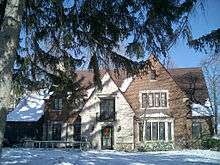
The Palmer Woods Historic District is named after Thomas W. Palmer, a prominent citizen of nineteenth-century Detroit and a United States Senator. Palmer's estate included land on both sides of Woodward Avenue, stretching from Six Mile Road to Eight Mile Road.[4] During his lifetime, Palmer donated some of his land to the city of Detroit to establish Palmer Park, and gave additional land to the state of Michigan to build the Michigan State Fairgrounds.[4]
Palmer died in 1913; two years later, Detroit real-estate developer Charles W. Burton purchased the section of Palmer's estate that now encompasses the Palmer Woods Historic District.[4] Burton envisioned an exclusive neighborhood, catering to Detroit's richest citizens, with room for spacious and elegant homes. He hired the landscape architect Ossian Cole Simonds to design the layout of the development.[4] Cole laid out a subdivision with gently curving streets, capitalizing on the natural beauty of the area and creating a parklike atmosphere in the neighborhood. Curbs are nonexistent, minimizing the transition from street to lawn and discouraging pedestrian traffic, and every lot in the neighborhood had a unique shape.[4] The neighborhood received the Michigan Horticultural Society's Award of Merit in 1938 for being the finest platted subdivision in Michigan.[5]
Many Colonial Revival and Tudor Revival styled homes were constructed between about 1917 and 1929.[4] After World War II, additional mansions were constructed.[4]
In 2007 and 2008 there were around 24 residential properties that were vacant.[2]
By 2011 the community established its own private security service.[6]
By 2014, housing prices, which had previously declined, began to rebound.[2]
Architecture
Palmer Woods is known for its elm-lined streets, large brick and stone homes in Tudor Revival architecture, set back from the street behind contiguous uninterrupted lawn.[7] Lots are large, with ample room for trees, play equipment, and a good expanse of grass. There may be Scottish coats of arms, leaded stained glass windows, and other features, such as elevators in some of the homes. Some of the properties boast more than one structure: such as a house and guest house, or maids' quarters. Streets gently curve through the forested neighborhood.
Palmer Woods has its own security service and an active voluntary neighborhood association. The home of physicians, politicians, business owners, artists, executives and their families, the Palmer Woods neighborhood has attracted some of Detroit's most prominent citizens. Charles W. Burton himself made his home in the neighborhood. Two of the seven Fisher Brothers (owners of Fisher Body), Alfred and William, also lived in the neighborhood. William Fisher's house, on Wellesley, is 35,000 square feet (3,300 m2), one of the largest in Detroit.[4] John H. Kunsky, the founder of United Artists theatres, also lived in the area.[4]
Almost every house in Palmer Woods has unique architectural features, but a number are particularly important. At the southern edge of the district is the Dorothy H. Turkel House, the only house in Detroit designed by Frank Lloyd Wright.[4] C. Howard Crane, the noted theater architect, designed the home of John H. Kunsky, incorporating many theater elements into the design.[4] Minoru Yamasaki and Leonard B. Willeke also designed houses in the district.[4]
Bishop Gallagher House
Probably the most significant home in the district is the 62-room Bishop Gallagher residence.[9] The home was built for the Fisher Brothers in 1925, who hired the Boston firm of McGinnis and Walsh, specialists in ecclesiastical architecture, to design the Tudor Revival mansion.[7][8] Upon completion, the Fishers gave the mansion to Bishop Michael Gallagher, of the Roman Catholic Archdiocese of Detroit.[4] The 40,000-square-foot (3,700 m2) home is the largest within the city of Detroit.[4]
The two-story brick residence consists of a large central structure flanked by diagonal wings.[8] There are numerous exterior bays, each topped with a parapet capped with masonry and a finial. Religious themes are included throughout the house, both on the exterior and the interior.[8] On the exterior, medallions, shields and crests are set into the brickwork, and a copper statue of the Archangel Michael defeating Satan is prominent.[8] The interior is finished with oak, stone and masonry. The house had, at one time, the largest collection of Pewabic glazed pottery tile in Michigan.[8]
Bishop Gallagher lived in this home until his death in 1937.[8] Subsequent archbishops of Detroit Cardinals Edward Mooney and John Francis Dearden also lived in the home. Upon Cardinal Dearden's death, the archdiocese sold the house to John Salley of the Detroit Pistons.[8] Forbidden Fruits (2006), a movie produced by Marc Cayce, was filmed inside the Bishop Gallagher residence.[9]
Education
Palmer Woods is within the Detroit Public Schools district. Residents are zoned to Palmer Park Preparatory Academy, formerly the Barbara Jordan School,[10] for elementary and middle school.[11][12] All residents are zoned to Mumford High School.[13] Palmer Park is operated by teachers and not by a principal administrator.[14]
Notable residents
References
- 1 2 National Park Service (2008-04-15). "National Register Information System". National Register of Historic Places. National Park Service.
- 1 2 3 4 Reindl, JC (2014-04-27). "Home sales up in Detroit's Indian Village, other historic mansion areas". Detroit Free Press. Retrieved 2016-10-02.
- 1 2 Reindl, JC. "GM president buys Detroit's Fisher Mansion for $1.55M" (Archive). Detroit Free Press. September 15, 2015. Retrieved on October 20, 2015.
- 1 2 3 4 5 6 7 8 9 10 11 12 13 14 15 Palmer Woods Historic District from Detroit1701.org
- ↑ Palmer Woods Historic District from the National Park Service
- ↑ Dawsey, Darrell (2011-06-06). "Private security in Palmer Woods shows how commitment to living in Detroit can be taxing". MLive. Retrieved 2016-10-01.
- 1 2 3 Hill, Eric J. and John Gallagher (2002). AIA Detroit: The American Institute of Architects Guide to Detroit Architecture. Wayne State University Press.
- 1 2 3 4 5 6 7 8 Bishop's Residence from Detroit1701.org
- 1 2 McDonald, Maureen (November 28, 2006).Visit with a Giant. Model D Media. Retrieved on December 23, 2008.
- ↑ "DPS teachers to hold Enrollment Fair for Palmer Park Preparatory Academy, a new teacher-led school." (Archive) Detroit Public Schools. August 13, 2010. Retrieved on November 1, 2012.
- ↑ "Elementary Boundaries - 2012/13 School Year." (Archive) Detroit Public Schools. Retrieved on November 1, 2012.
- ↑ "Middle School Boundaries - 2012/13 School Year." (Archive) Detroit Public Schools. Retrieved on November 1, 2012.
- ↑ "High School Boundaries - 2012/13 School Year." (Archive) Detroit Public Schools. Retrieved on November 1, 2012.
- ↑ Winerip, Michael. "For Detroit Schools, Mixed Picture on Reforms." The New York Times. March 13, 2011. Retrieved on November 9, 2012.
| Wikimedia Commons has media related to Palmer Woods Historic District. |
External links
- Palmer Woods Home Page
